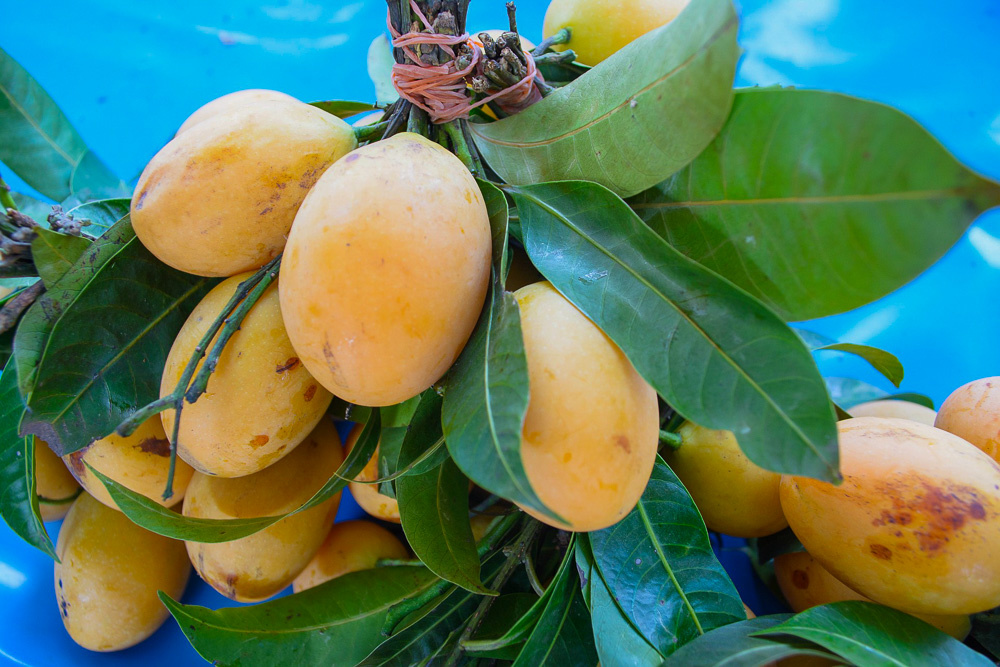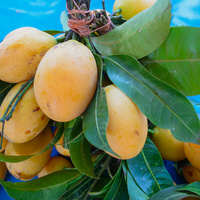Common name: Marian Plum
Other common names: Marian Mango, Plum Mango
Description
Marian Plum is a Mango (Mangifera indica) relative native to Southeast Asia, its natural range extending from peninsular Malaysia to Sumatra and West Java in Indonesia. Nowadays, it is regularly encountered in Thailand, in the central provinces, where it is grown commercially for its fruit.
In cultivation, it is typically 10 to 15 m (33 to 50 ft) tall, though it may reach up to 20 m (66 ft) in natural forests. It is a handsome tree with a slim, straight trunk and a densely leafy rounded crown. The bark is thin, pale brown and slightly fissured.
Leaves are elliptic and pointed, 10 to 30 cm (4 to 12 in) long, red-violet when they emerge, becoming dark glossy green with prominent veining and a leathery texture. They are arranged in pairs on long, drooping branchlets and remain on the tree in all seasons.
Flowers are tiny, greenish and closely packed in pyramidal-shaped clusters up to 12.5 cm (5 in) long, arising at the sides and ends of the branches. They bloom in winter, coinciding with the start of the dry season. Fertilised flowers develop into mango-like fruit, only smaller, around 3 to 7 cm (1.5 to 2.8 in ) long, around the size and shape of a duck egg. The skin is thin, green, and, like the pulp, becomes orange when ripe, around four to five months after fruit-set and with a single seed at the centre.
All parts of the tree produce a resinous aroma, including the fruit. However, this aroma varies in strength among varieties and individual trees, as does the flavour of the fruit, which ranges from very sour to sweet. Only commercial types producing sweet, low to non-resinous fruit are described here.

Image by Thaizeal from Pixabay
Use
The ripe fruit are eaten fresh out-of-hand, usually only the pulp but sometimes the pulp and skin together (owing to the skin being thin and edible). The pulp has a flavour and texture similar to a quality mango, with a sweet to mildly sourish taste and a soft, slightly fibrous and juicy texture.
Chutneys are made following mango chutney recipes and sambals (spicy Asian condiments) using green or unripe fruit.
The tree is also appreciated in gardens in its native range for its shapely form, lush green foliage and shade.
Climate
Although occurring naturally in humid tropical forests in Southeast Asia, most commercial orchards are in seasonally dry areas in Central Thailand.
The tree is most productive in warm tropical climates, generally frost-free areas with annual lows of 18 to 25°C, annual highs of 27 to 35°C, annual rainfall of 1000 to 4500 mm and a dry season of 3 to 6 months, extending to 8 months or more with irrigation.
Growing
New plants can be started from seed or cuttings. Good practice is to select vegetative material from trees known to produce good quality, sweet, non-resinous fruit.
Performs best on rich, free-draining clay, loam and sand soils of a moderately acid to neutral nature, generally with a pH of 5.5 to 7.5, and on sites with full to partial sun exposure. It has poor tolerance to alkaline or limestone soils.
Problem features
There does not appear to be any records of escape or naturalisation, despite its cultivation outside its native range. It is assessed as a low weed risk species for Hawaii by the Hawaii Pacific Weed Risk Assessment (HPWRA) project.
Where it grows
References
Books
-
Allen, B. M. 1967, Malayan fruits : an introduction to the cultivated species, Donald Moore Press, Singapore
-
Holttum, R. E. & Enoch, I. C. 2010, Gardening in the tropics : the definitive guide for gardeners, Marshall Cavendish Editions, Singapore
-
Jensen, M. 1999, Trees commonly cultivated in Southeast Asia : an illustrated field guide, 2nd ed., Food and Agricultural Organisation of the United Nations (FAO) Regional Office for Asia and the Pacific (RAP), Bangkok
-
Macmillan, H. F. 1943, Tropical planting and gardening : with special reference to Ceylon, 5th ed, Macmillan Publishing, London
-
Martin, F. M., et al. 1987, Perennial edible fruits of the tropics : an inventory, U.S. Dept. of Agriculture (USDA), Agricultural Research Service, U.S. Government Printing Office (GPO), Washington, D.C.
-
Martin, F. W & Ruberte, R. M. 1975, Edible leaves of the tropics, U.S. Agency for International Development (USAID), and the Agricultural Research Service, U.S. Department of Agriculture (USDA), Mayaguez, Puerto Rico
-
Morton, J. F. & Dowling, C. F. 1987, Fruits of warm climates, Creative Resources Systems, Winterville, North Carolina
Articles, Journals, Reports and Working Papers
-
Subhadrabandhu, S. 2001, Under-utilized tropical fruits of Thailand, Food and Agriculture Organisation of the United Nations (FAO), Regional Office for Asia and the Pacific (RAPA), Bangkok


